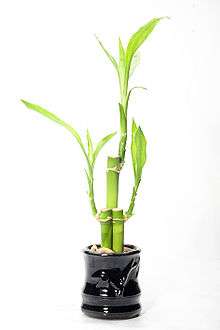Dracaena sanderiana
Dracaena sanderiana is a species of flowering plant in the family Asparagaceae, native to Central Africa.[2] It was named after the German–English gardener Henry Frederick Conrad Sander (1847–1920). The plant is commonly marketed as "lucky bamboo". The plant has become the most popular indoor plant in certain parts of India, where the plants are usually imported from China and Taiwan.[3]
| Dracaena sanderiana | |
|---|---|
 | |
| Scientific classification | |
| Kingdom: | Plantae |
| Clade: | Tracheophytes |
| Clade: | Angiosperms |
| Clade: | Monocots |
| Order: | Asparagales |
| Family: | Asparagaceae |
| Subfamily: | Nolinoideae |
| Genus: | Dracaena |
| Species: | D. sanderiana |
| Binomial name | |
| Dracaena sanderiana Mast.[1] | |
| Synonyms[1] | |
| |
Names
Common names include Sander's dracaena, ribbon dracaena, lucky bamboo, curly bamboo, Chinese water bamboo, Goddess of Mercy's plant, Belgian evergreen, and ribbon plant.[4] Although the word bamboo occurs in several of this plant's common names, D. sanderiana is of an entirely different taxonomic order from true bamboos – though it is worth noting that this plant and true bamboos both fall under the monocot clade. Despite several of its common names that suggest it is from China or Belgium, it is a native African species. Dracaena sanderiana is often confused with Dracaena braunii, a plant from coastal West Africa with flowers 5 times shorter than those of D. sanderiana.[2]
Description
A perennial herb reaching a height of 100 cm (39 in), the plant has slightly twisted leaves of grey-green colour, with a length of which is up to 23 cm (9 in). The stem is fleshy, which distinguishes it from bamboo. It requires bright, ventilated areas. It tolerates dry air and does not require constant spraying. A very tenacious plant, it is rather difficult to destroy it.[3]
Cultivation
Dracaena sanderiana and its related varieties are popular houseplants. It is a suitable plant in a confined space, and the most suitable place is a scattered light or semi-shade site because direct sunlight causes yellowing and burning of leaves. Ideal temperature ranges from 15 to 22 °C (59 to 72 °F). It requires average warmth, good illumination, regular watering and water spray. If planted in the ground, it loses its bamboo-like look and it would fill with a leaf-like shape like other dragon trees.[3]
It is multiplied by cutting a part of the stem just above the eye. Cuttings can be made year round.
Gallery
- A field of lucky bamboo in Donghai Island, Guangdong
 Lucky bamboo spiral houseplant
Lucky bamboo spiral houseplant Newly propagated lucky bamboo cutting with roots forming
Newly propagated lucky bamboo cutting with roots forming Plant with multiple, woven stems.
Plant with multiple, woven stems. With heart-shaped stems.
With heart-shaped stems. Top of plant closeup.
Top of plant closeup.
References
- "Dracaena sanderiana". World Checklist of Selected Plant Families. Royal Botanic Gardens, Kew. Retrieved 2018-03-04.
- Damen, T.H.J. (2018). "Taxonomic novelties in African Dracaena (Dracaenaceae)". Blumea journal of plant taxonomy and plant geography. 63: 31–53.
- Mustafah, K.K. (8 June 2010). "Lucky bamboo". The Hindu Business Line. Retrieved 5 August 2013.
- Hugh T. W. Tan and Xingli Giam (2008). Plant Magic: Auspicious and Inauspicious Plants from Around the World. Marshall Cavendish Editions. p. 62. ISBN 9789812614278.
See also

